Apuntes Para Mis Obras
: Granados's Most Personal Manuscript and What It Reveals
Douglas Riva
The Pierpont Morgan Library in New York holds
a sketchbook by Enrique Granados (1867-1916), and it is
without doubt one of Granados's most intriguing manuscripts.
Apuntes para mis obras (Notes for My Works), the
title of the sketch book, contains sketches for the Tonadillas
and other works which, along with the piano suite
Goyescas and the opera of the same title, are united
by the common source of inspiration—the paintings of Francisco
Goya (1746-1828). Our understanding of Granados's genius
is greatly enhanced by studying this sketchbook.
Apuntes para mis obras is a black
leather-grained cloth-bound notebook, measuring 11.5 x 17
cm. In reality it consists of two separate notebooks that
are glued together and covered with one outer binding. The
first notebook consists of thirty-five pages, and the second,
of thirty-six pages of graph paper. Following the cover,
the first page of the manuscript states its title. The second
page bears a title for the musical sketches that fill the
first seventeen pages: Apuntes y temas para Ovillejos
(la gallina ciega ) [Notes and Themes for
Ovillejos (la gallina ciega )].
Granados did not place a date on any page of
Apuntes para mis obras. Since he said that he began
Ovillejos in 1900, we may assume that the sketches
relating to the opera were written around that time. The
Tonadillas, however, were not published until 1912.
Consequently, since Apuntes para mis obras contains
so many sketches for these songs, it is possible that he
continued to write in the notebook during the intervening
years.
For many years Apuntes para mis obras
was in the private library of the great Italian diva Amelita
Galli-Curci (1882-1963). Mme. Galli-Curci enjoyed an overwhelming
success in Barcelona during the 1913-1914 and 1914-1915
seasons, where she interpreted leading roles in Lucia
di Lammermoor, La Sonnambula, and Il Barbiere
di Siviglia, among other operas. Although it is not
known precisely how Apuntes para mis obras came
into her possession, it is not unreasonable to hypothesize
that Granados presented the sketchbook to Mme. Galli-Curci
in admiration for her art. However, it is also possible
that Granados's son Víctor either gave or sold the
manuscript to Mme. Galli-Curci during the period when both
were living in California, ca. 1960. Upon Mme.
Galli-Curci's death in November of 1963, Apuntes para
mis obras came into the possession of her close friend
William Seward of New York . Mr. Seward retained the manuscript
in his archive until it was acquired by the Pierpont Morgan
Library in 1985.
Granados's musical sketches in Apuntes
para mis obras include the sketches for Ovillejos-La
gallina ciega, and sketches for some of the Tonadillas
along with verses to be used as possible texts for
them. Curiously, none of his piano works are sketched in
the manuscript. Other material includes a paragraph describing
the composer's view of his Tonadillas and their
origins; pedagogical information; notes on orchestration;
drawings in the style of Goya of majas and majos
in pencil, ink and pastels; personal information (including
measurements for a standing screen and curtains and addresses)
and lists of works composed as well as projected works.
Some of the charming drawings are titled; others, including
a self-portrait, are not.
Granados began drawing early in his life. While
a student in Paris, 1887-1889, he sketched regularly with
his friend the painter Francesc Miralles (1848-1901). However,
for Granados sketching was not merely a student fancy but
an activity that he continued as a mature composer. In Apuntes
para mis obras Granados drew nine sketches of majas
and majos inspired by the art of Goya. Granados's
drawings show him to be a skilled amateur artist. There
are two drawings titled La maja de paseo (The
maja out for a walk), one executed in black ink and the
other in black ink colored with yellow, red, and green pastel
(figs. 1-2); two titled La maja en el balcón
(The maja on the balcony), one done in black ink and
the other in black ink, pencil and yellow and red pastel
(figs. 3-4; no. 3 also includes a self-portrait and La
maja dolorosa); and an untitled black ink drawing of
a majo (fig. 5). None of these drawings are related
to specific compositions by Granados. However, La maja
dolorosa (The sad maja), drawn in black ink,
could be related to the inspiration for the three Tonadillas
of the same title. Coloquio en la reja (Dialogue
through the grill), a drawing in black ink and pencil accented
with blue, yellow, and brown pastel (fig. 6), is also the
title of the second piece of the piano suite Goyescas.

Fig. 1: Granados, La maja de paseo
(The maja out for a walk)
Courtesy of Pierpont Morgan Library, New York

Fig. 2: Granados, La maja de paseo (The
maja out for a walk)
Courtesy of Pierpont Morgan Library, New York

Fig. 3: Granados, La maja dolorosa
(The sad maja),
self-portrait, and La maja en el balcón
(The maja on the balcony)
Courtesy of Pierpont Morgan Library, New York

Fig. 4: Granados, La maja en el balcón
(The maja on the balcony)
Courtesy of Pierpont Morgan Library, New York

Fig. 5: Granados, Majo
Courtesy of Pierpont Morgan Library, New York

Fig. 6: El coloquio en la reja (Dialogue
through the grill)
Courtesy of Pierpont Morgan Library, New York
Apuntes para mis obras contains one
page, which shows evidence that a drawing similarly executed
in black ink colored with brown pastel was removed from
the manuscript. Perhaps this drawing is one of a maja
(in the collection of Antonio Carreras Granados, grandson
of the composer).
As a piano teacher, Granados was highly successful.
Certainly he devoted a considerable portion of his life
to his students. It is not surprising, therefore, that Granados
included some of his pedagogical ideas in Apuntes para
mis obras. Many musicians and teachers will agree with
Granados's "Advice for Students" included in the manuscript
: "The most well-known works must be studied first."1
Granados also described some of the concepts for his piano
technique in the manuscript:
Technique is composed of strength, equality
and agility.
What contributes to strength?
Articulation.
The position of the body, arm and hand.
What contributes to equality [of the fingers]?
The balance of equal strength in all of the fingers.
What contributes to agility?
The suppression of all useless movement.2
Although Granados's introduction to the works
of Goya and his subsequent inspiration by Goya's art are
usually attributed to Fernando Periquet (1873-1940), librettist
for both the Tonadillas and the opera Goyescas,
Granados's first "goyesca" was in fact Ovillejos,
an opera with a libretto by José Feliu y Codina
(1845-1897). Its subtitle, La gallina ciega (Blind
Man's Bluff), is the same as the title of a famous Goya
painting. In an interview the composer stated that Ovillejos
was begun in 1900 and that he originally wrote El
fandango de candil, the third piece of the piano suite
Goyescas, for Ovillejos, but due to the
librettist's untimely death, the project was dropped.3
The first sketch for Ovillejos appears
on the second page of Apuntes para mis obras. The
character of the music would indicate that Granados intended
that music as an introduction or overture to the opera.
Since it is a sketch, the music is scored for piano and
not orchestrated. An excerpt from the sketch follows:
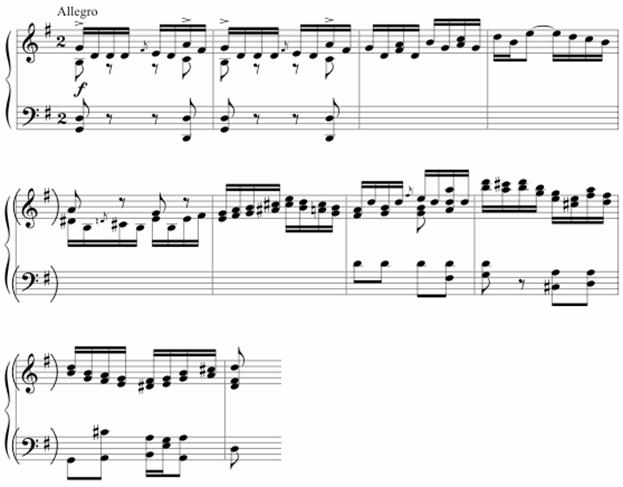
Ex. 1: Granados, excerpt from Ovillejos
The following pages include: 1) a scene scored
for chorus and piano, 2) fourteen measures of music scored
for piano labeled Introducción y intermedio,
and 3) other short sketches. Some of this material was later
expanded and orchestrated by Granados in a separate and
unpublished manuscript titled La gallina ciega,
now preserved in the Centre de Documentació Musical,
Barcelona.
One of the most interesting aspects of the
material relating to Ovillejos found in Apuntes
para mis obras is the way in which Granados develops
an eight-measure sketch for piano with the text Aunque
ya te lo hayan dicho (Although they might have already
told you), presented as ex. 2. This example and all remaining
examples are complete as they appear in Apuntes para
mis obras.
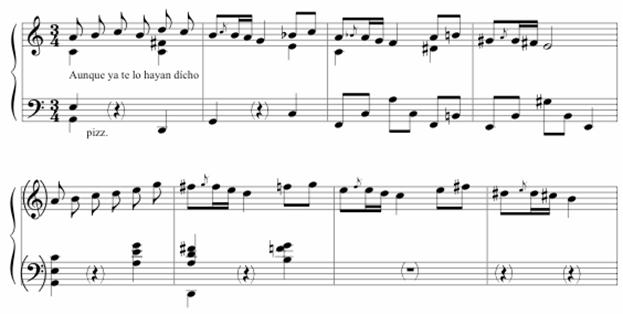
Ex. 2: Granados, sketch for Ovillejos
The initial idea is expanded in ex. 3. Although
still scored for piano, in this sketch Granados now indicates
his ideas for possible future orchestration by these indications:
Cuerda, Ob. Fl. (strings, ob[oe], fl[ute]) and
Clar. (clar[inet]).
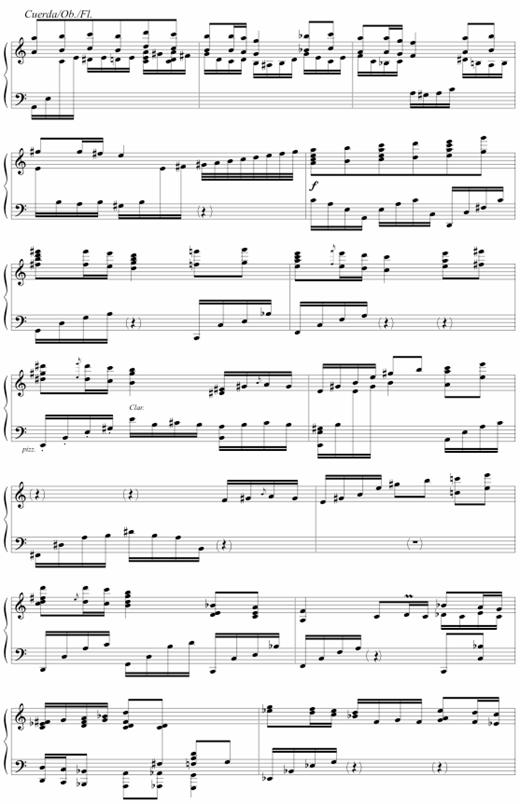
Ex. 3: Granados, sketch for Ovillejos
The first instrumentación
(orchestration) of this material, as labeled by Granados,
appears as ex. 4. Note that the melody is taken by the Oboe
and Corneta (cornet).
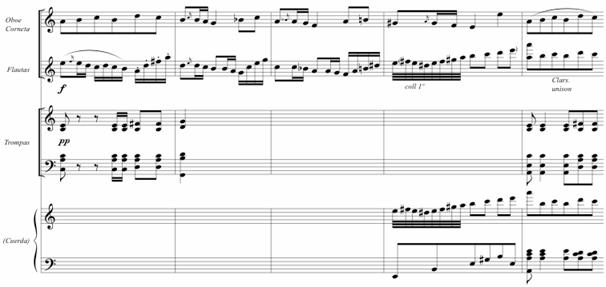
Ex. 4: Granados, sketch for Ovillejos
An alternate instrumentation for the music
appears as ex. 5. Notice how in this case Granados assigns
the melody to the Cello and Fagot (bassoon).
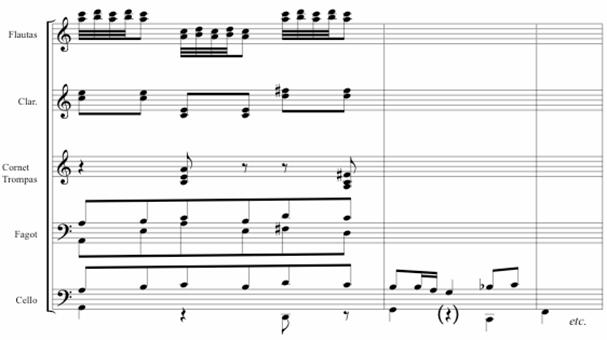
Ex. 5: Granados, sketch for Ovillejos
Apart from notating his orchestral sketches
in Apuntes para mis obras, Granados details some
of his ideas for the orchestration as follows:
An expressive melody with oboe and cornet
playing piano. Combining the strings, half playing
pizzicato, half bowed, against dotted notes in
the high register and with mute.
Motives of flute along with strings playing
with the mute.
Cornet playing noisily in the high register,
F, G, A-flat. With insistence.
Flute playing piano in the middle
register, combined with the bassoon in unison, 2 octaves
apart.
Clarinet doubling legato and piano
a motive with little movement, pizzicato
in the strings and harp.
Flute, lyre and strings in the high register.
Violins on the high strings along with the
soprano voice and sometimes doubled by a trumpet an octave
lower.4
Although a detailed comparison of Granados's
ideas for orchestration as notated in Apuntes para mis
obras with his completed orchestral works and operas
is beyond the scope of this paper, it would be interesting
to study how he might have realized these ideas in Ovillejos
and other operas such as Follet and María
del Carmen and in symphonic works such as Dante,
Liliana, Danza de los ojos verdes, Danza gitana,
and Suite sobre cantos gallegos.
Without doubt, the Tonadillas are
among Granados's greatest works. For Antonio Fernández-Cid,
the Tonadillas are "the most perfect achievement,
the most mature and refined, the most personal of all [the
works] which carry the signature of Enrique Granados."5
In Apuntes para mis obras, Granados
explains something of the importance he attached to his
Tonadillas:
[The] collection of Tonadillas [is]
written in the classic mode (originals). These Tonadillas
[are] originals; they are not those previously known
and harmonized. I wanted to create a collection that would
serve me as a document for the Goyescas. And it
has to be known that with the exceptions of Los requiebros
and Las quejas, in no other of my Goyescas
do you encounter popular themes. They are written
in a popular style, yes, but they are originals.6
In Apuntes para mis obras, Granados
compiled a list of Tonadillas he had written up
to that time. They were:
- La maja de Goya
- El majo discreto
- El tralalá y el punteado
- La maja dolorosa (1)
- La maja dolorosa (2)
- La maja dolorosa (3)
- El majo tímido
- El mirar de la maja
Of the Tonadillas he listed,
Apuntes para mis obras contains sketches for five
which he later completed: El tralalá y el punteado,
La maja dolorosa (1), La maja dolorosa
(2), La maja dolorosa (3), El majo tímido,
and El mirar de la maja. There are also sketches
for two that he never completed, El amor del majo
and El garbo, as well as poems and a brief untitled
musical sketch that corresponds to Las currutacas modestas.
The sketches for the Tonadilla El tralalá
y el punteado are placed by the composer on facing
pages. The verses appear on the left-hand page and the score
on the right. Granados's verses are as follows:
Si vienes de nadie y solo
Ven pronto y armado
Que los hombres de esta tierra
Son todos muy malos.
Ay tra la la la la la
La la la la la la la
Mira que no te deslices.
Tra la la la la la la
Mira que no te den paliza
porque puede ser que te den.
Tra la la la la la la.
The published version of El tralalá
y el punteado contains a totally different text, by
Fernando Periquet. Nevertheless, Granados's musical sketch
is virtually identical with the published version, lacking
only the four-measure introduction found in the published
version. Periquet's text follows:
Es en balde, majo mío,
que sigas hablando,
porque hay cosas que contesto
yo siempre cantando.
Por más que preguntes tanto,
en mí no causas quebranto
ni yo he de salir de mi canto.7
The music for La maja dolorosa (No.
1), which is known in the published version as No. 2, differs
from the published version only in details of notation.
Granados's sketch for the text, which appears in Apuntes
para mis obras on the facing page, is quite different
from the published version by Periquet. Granados's text
for La maja dolorosa (No. 1) is:
Majo de mis amores
que fue de tu vida?
Pobre majo
de mis amores!
Muerte traidora
se me llevó el alma mía
Ay, mi pobre vida!
Periquet's text for the published version of
La maja dolorosa (No. 1) follows:
¡Ay majo de mi vida,
no, tú no has muerto!
¿Acaso yo existiese
si fuera eso cierto?
¡Quiero loca
besar tu boca!
Quiero segura
gozar más de tu ventura.
Más ¡ay! Delirio, sueño,
mi majo no existe;
en torno mío el mundo
lloroso está y triste.
¡A mi duelo
no hallo consuelo!
Mas muerto y frío
siempre el majo será mío.
For La maja dolorosa (No. 3) in Apuntes
para mis obras , Granados prepared a set-up of staves,
clefs, and a key signature of three sharps. However, not
one note of music was written. The facing page contains
the black ink drawings titled La maja dolorosa, La maja
en el balcón , and the untitled self-portrait.
On a separate page, above the indication Hecha la letra
[Text completed], Granados wrote the following text
titled La maja dolorosa (No. 3):
Mi vida triste
Llena de dolor y recuerdos
Se ha resignado .
Y voy llorando
Recordando al bien amado
Y de mi llanto
Voy viviendo ahora sol
En mi dolor.
(Hecha la letra)
In spite of Granados's notation (Hecha
la letra), Periquet's text for the published version
of La maja dolorosa (No. 3) is completely different:
De aquel majo amante que fue mi gloria
guardo anhelante dichosa memoria.
El me adoraba vehemente y fiel,
yo mi vida entera di a él.
Y otras mil diera si él quisiera,
Que en hondos amores martirios son flores.
Y al recordar mi majo amado
van resurgiendo ensueños
de un tiempo pasado.
Ni en el Mentidero ni en la Florida
majo más majo paseó en la vida.
Bajo el chambergo sus ojos vi
con toda el alma puestos en mí,
que a quien miraban enamoraban,
pues no hallé en el mundo mirar más profundo.
Y al recordar mi majo amado
Van resurgiendo ensueños
de un tiempo pasado.
Granados's sketch for El majo tímido
in Apuntes para mis obras is not complete.
However, the music, as notated there, does not differ significantly
from the final published version, although, as in the case
of El tralalá y el punteado, the introduction
found in the published version is not present in this manuscript.
Granados's text for El majo tímido appears
on the page facing the musical sketch in Apuntes para
mis obras:
Se de cerca no te veo
que quieres que diga.
No si eres guapo o feo
Acércate, lila.
¡Ay que tímido!
¡Ay que tímido!
No se acerque señor majo
que a mi no me engaña.
No se acerque señor majo
que yo no le quiero.
Si creyó que le esperaba
no es mi pensamiento.
¡Ay que tímido!
¡Ay que tímido!
No se escurra el señor majo
que no le creo.
Periquet's text for the published version of
El majo tímido follows:
Llega a mi reja y me mira
por la noche un majo
que en cuanto me ve y suspira
se va calle abajo.
¡Ay, que tío
más tardío!
Si así se pasa la vida
estoy divertida.
Si hoy también pasa y me mira
y no se entusiasma,
pues le suelto este saludo:
Adiós, Don Fantasma.
¡Ay, que tío
más tardío!
Odian las enamoradas
las rejas calladas.
Granados's sketch for another Tonadilla,
El mirar de la maja, in Apuntes para mis obras
does not differ significantly from the published version.
This sketch includes sixteen measures identical to the corresponding
measures of the published version. However, there are an
additional nine measures, the final measures of the sketch,
which lack the piano accompaniment. The text is only hinted
at by three brief phrases.
In Apuntes para mis obras, intermingled
with sketches for Ovillejos, Granados wrote three
measures of music that are not titled or identified in any
manner. These three measures, in ex. 6, are clearly a sketch
for the Tonadilla, Las currutacas modestas.

Ex. 6: Granados, sketch for Las currutacas
modestas
The sketch in ex. 7 for the projected Tonadilla
El amor del majo is decidedly similar to a portion
of Coloquio en la reja from the piano suite Goyescas.
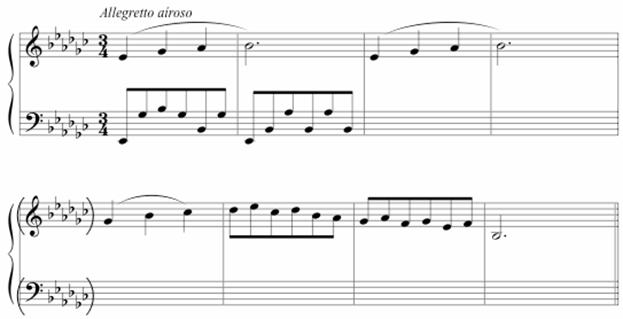
Ex. 7: Granados, sketch for El amor del
majo
Compare the melody of El amor del majo,
ex. 7, with ex. 8, from Coloquio en la reja, mm.
166-76.

Ex. 8: Granados, excerpt from Coloquio en
la reja, mm. 166-76
The sketch in ex. 9, titled El garbo,
however, does not appear to have a relationship to any of
Granados's completed works. In the last line of the sketch,
Granados indicated the harmonies to be used by the indications:
Fa, Si bemol, Sol. Do, Fa, without actually writing
the accompaniment.
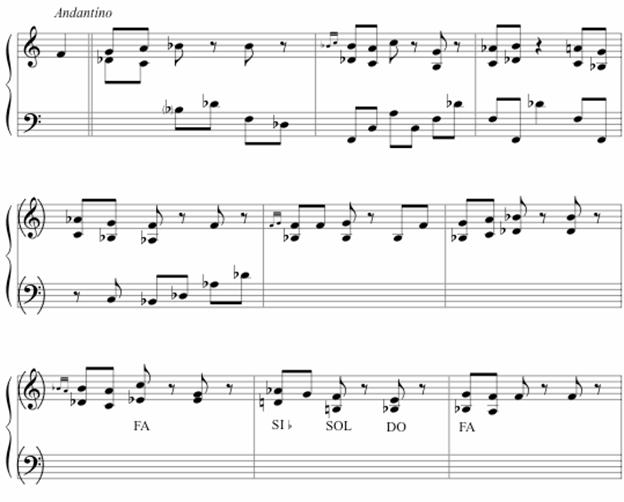
Ex. 9: Granados, sketch for El garbo
In Apuntes para mis obras, Granados
wrote two untitled texts that are not related to specific
works. Both of these texts, presented below, appear to be
possible texts for other Tonadillas. The first
of these is:
Con garbo y con donaire
Va el majo galán
Va el majo galán
Pasito a paso por la pradera
Va por la pradera
The words of the first line of this text were
later used by Granados as an expressive indication in Los
requiebros from the piano suite Goyescas: Con
garbo y donaire. The second untitled text in Apuntes
para mis obras was written upside down:
Los majos que a mi me quieran
han de ser de la sal y pimienta
Por eso lo quiero yo
y yo los quiero tanto.
Por eso los quiero
llamando al portal.
Los llamo y los quiero
con todo mi amor.
¿ Porque no me digan
que soy de rigor?
Y digo que si,
que!
no!
Eso mismo digo yo.
As a whole, Granados's Tonadillas
have a melodic grace and a directness of expression that
are immediately captivating. The vocal melodies are completely
natural and of a simplicity that only the most refined artistic
personality could conceive. The piano accompaniment, which
frequently imitates the guitar, surrounds the voice, supporting
but never overwhelming the exquisite delicacy of the vocal
lines. José Subirá believed that in the Tonadillas,
Granados's achievement in capturing the spirit of the eighteenth
century and transforming it into his own musical language,
without loosing any of the original attributes of the era,
created an entirely new genre, "un genuíno
lied . . . a la española' [A genuine lied
. . . in the Spanish style].8
Frank Marshall, Granados's disciple, believed
that "Granados created the Tonadillas complete,
or in other words, [he created] the literary part and the
musical part at the same time." 9
The musical sketches and the verses for the Tonadillas
found in Apuntes para mis obras appear to
bear out this opinion, at least in part. For example, three
of the sketches for Tonadillas for which Granados
wrote both music and texts in the manuscript are considerably
developed, although none is a definitive version. When we
consider that the music Granados composed for the Tonadillas,
as notated in Apuntes para mis obras, is substantially
similar to the final versions, it seems likely that at some
point Granados must have realized that the texts he had
sketched in the manuscript were not of a comparable level
of artistic merit as his music. Thus, he abandoned them
and turned to Fernando Periquet to write the definitive
texts.
Therein lies one of the revelations of Apuntes
para mis obras: in two of his greatest works, the Tonadillas
and the opera Goyescas, Granados appears
to have broken with the standard practice of composers who
normally compose their music to fit an author's text. The
sketchs in Apuntes para mis obras indicate that
since the music for the Tonadillas was largely,
if not entirely, complete by the time Periquet began writing
the texts, it would appear that Granados left Periquet to
write a text for a pre-existing score. Similarly, only a
few years later Granados and Periquet followed this highly
unorthodox procedure when writing the opera Goyescas.
As early as 1912, Granados was working on the
score of the projected opera Goyescas. In the piano
suite Goyescas, Granados had already written a
considerable amount of music that he was to use in the opera.
However, he lacked a libretto. Not surprisingly, he turned
to Fernando Periquet.
The story of the writing of Goyescas is
well documented. Periquet explains that the score of the
opera was composed in a particularly unusual manner. He,
Periquet, wrote a narrative poem based on the final plot,
which he submitted to Granados. Referring to this text Periquet
told Opera News: ". . . not intending that the
musician should set my verse to music but that Granados
might let his fancy roam over the scenes and stories I had
built of my rhymes. So was his charming score composed,
without words, in the most absolute freedom, while seeing
in his imagination a gorgeous pageant of Goyesque figures."
10
After the music was written, Periquet was given the almost
impossible task of creating a libretto that would fit the
music.
Periquet describes the difficulty: "When
the last note of his music was set down there fell on me
a hard . . . task, a painful tour de force, . .
. I had to write new words for the music! What I wrote for
Granados's music were [sic] not, could not be verse. The
speeches of the characters had to follow, note by note,
the maestro's fantasy. The rhymes were exotic,
the rhythms irregular."11
Periquet's description is certainly accurate
in that the text could not be considered as verse. By any
standard the libretto is crude. Many critics have observed
that the method adopted by Granados and Periquet of affixing
the libretto to the already composed score did not achieve
a convincing result, and not surprisingly, Periquet's libretto
received much merited criticism following the premiere of
the opera in January 1916. A review published in The New
York Herald Tribune described the problem: "There
can be no doubt that the librettist in his effort to affix
words to Granados's music was led more by his intention
to supply a word for each note than by the dramatic demand
to express the meaning of the music in appropriate language.
By this crowding of words to short notes the vocal parts
become instrumental, . . . and the singer cannot do justice
. . . to the effectiveness of the vocal part as against
the orchestra."12However,
no such criticism can be applied to the Tonadillas.
It is likely that in creating both the Tonadilllas
and the opera Goyescas, Granados and Periquet
followed a similar procedure in each case by adding a text
to previously composed music. Nevertheless, the quality
of the result in the two instances is markedly different.
In the Tonadillas the music and text converge
in a work of undisputed genius while in Goyescas,
unfortunately, the text only rarely illuminates the music.
Many writers have noted that Granados was directly
inspired by specific works of Goya, specifically by Goya's
Caprichos, Tal para cual, and El amor y la
muerte, as well as by specific paintings such as El
pelele. Yet it was more than specific works by Goya
that fascinated Granados. Granados was less inspired by
Goya's art itself than by his own fantasy of Goya. It was
the atmosphere, the people and the details of their lives
within the context of Goya's Madrid , which spoke to the
composer. Granados stated that in the Tonadillas he
had created a collection that would serve him as a "document." Perhaps this music sets the atmosphere for Goyescas,
and the texts tell in words something of the situations
and actions of the type of people he had in mind when writing
Goyescas. When considered as such, the Tonadillas
along with the drawings found in Apuntes para
mis obras clearly illustrate the extent of Granados's
inspiration by and devotion to the works of Goya. This highly
personal inspiration, shown so vividly in this manuscript,
led Granados to compose some of the greatest works ever
written in Spain.
Most composers tend to confine their manuscript sketches only
to music. However, in Apuntes para mis obras Granados
reveals himself as a complete artist, coalescing his inspiration
by one of Spain's greatest painters through poetry, graphic
arts, and his own highly personal music.13
1
Consejos a los alumnos: Deben estudiarse con preferencia
las obras que mejor se saben.
2
El mecanismo se compone de fuerza, igualdad
y agilidad. / ¿Qué contribuye a la fuerza?
/ La articulación. / La posición del cuerpo,
brazo y mano. / ¿Qué contribuye a igualdad?
/ Equilibrio de fuerza por igual en todos los dedos. / ¿Qué
contribuye a la agilidad? / La supresión de todo
movimiento inútil.
3
Enrique Granados in "True History of the Goyescas,"
Francisco Gándara, Las novedades (New York),
April, 1916, 12-13.
4
Canto expresivo con oboe y cornetín tocando
piano. Combinado la cuerda, mitad pizicato / [sic],
mitad arco, contra puntístico en los altos y
con sordino. / Dibujos de flauta junta con cuerda en sordino.
/ Cornetín fragondo en la tesitura alta, fa, sol,
la bemol. Con insistencia. / Flauta tocando piano en registro
medio, combinada unisón con fagot, 2 octaves de distancia.
/ Clarinete doblando ligato [sic] y piano un dibujo
de escasa pasamiento, pizicato [sic] de la cuerda
y arpa. / Flauta y lira y cuerda en lo alto. / Violines
en la cuerda alta junto con la voz de timple y a veces doblando
por una tromba a la 8 baja.
5
". . . el mas perfecto logro, el mas sazonado y redondo,
el mas personal entre cuantos llevan la firma de Enrique
Granados." Antonio Fernández-Cid, Granados
(Madrid: Samarán Ediciones, 1956), 223.
6Colección
de Tonadillas escritas en modo clásico (originales).
Estas tonadillas originales, no son las conocidas anteriormente
y armonjadas. He querido crear la colección que me
sirve de documento para la obra Goyescas. Y ha de saberse
que a excepción de Los requiebros y Las quejas en
ninguna otra de mis Goyescas se encuentra temas populares.
Hecho en modo popular, sí, pero originales.
7
All texts by Periquet are quoted from Enric Granados, Integral
de l'obra per a veu i piano, ed. Manuel Garcia Morante
(Barcelona: Tritó, 1996).
8José
Subirá, "Granados tonadillero," in Enrique Granados,
Revista Musical Hispano-Americana (Madrid), April
30, 1916, 16-17.
9
". . . Granados ideó las Tonadillas completas, o
sea la parte literaria y la musical a un tiempo." Frank
Marshall in Fernández-Cid, Granados, 223.
10
Fernando Periquet, "Goyescas: How the Opera Was
Conceived," Opera News, January 29, 1916, 12.
11
Ibid.
12 "Goyescas, Spanish Opera: Brilliant Music, Not
Dramatic," New York Herald Tribune, January 29,
1916 .
Portions of this text were originally published as "El llibre d'apunts d'Enric Granados," Douglas Riva, trans. Joan Malaquer i Ferrer, Revista de Catalunya , n26 (January 1989): 89-106. |















